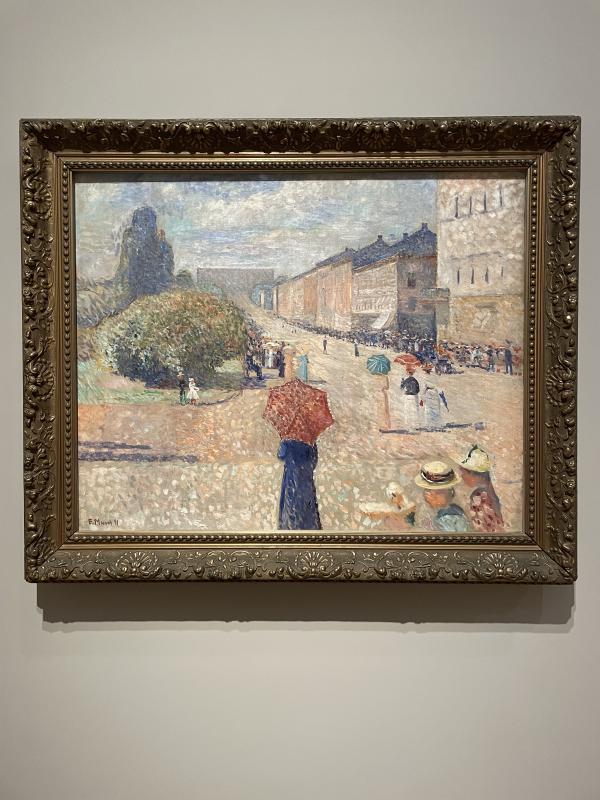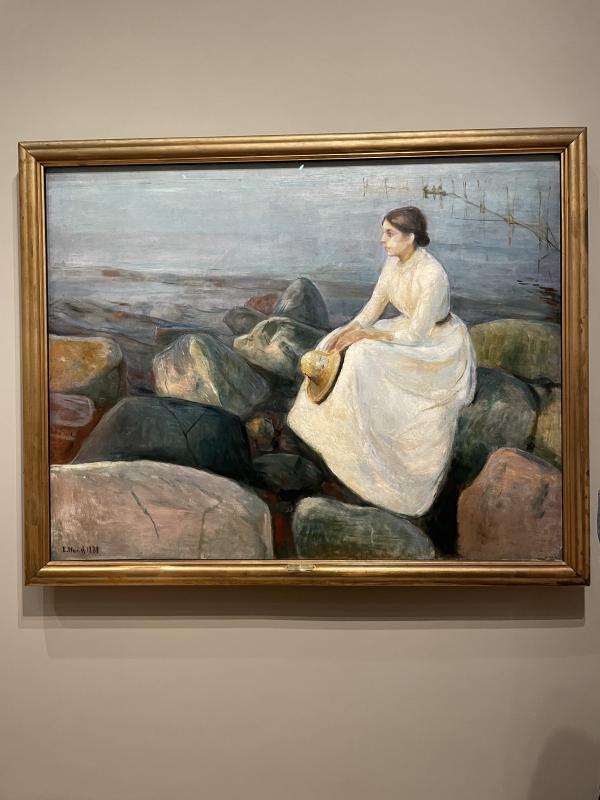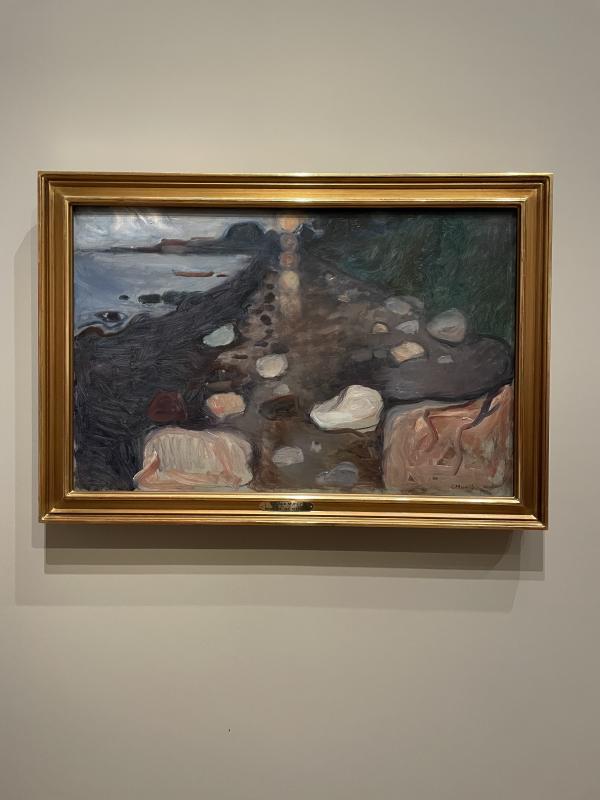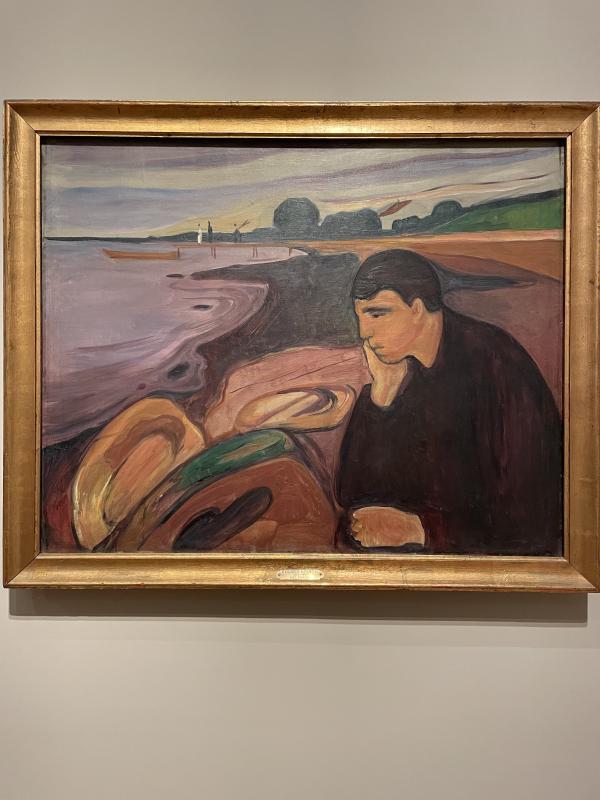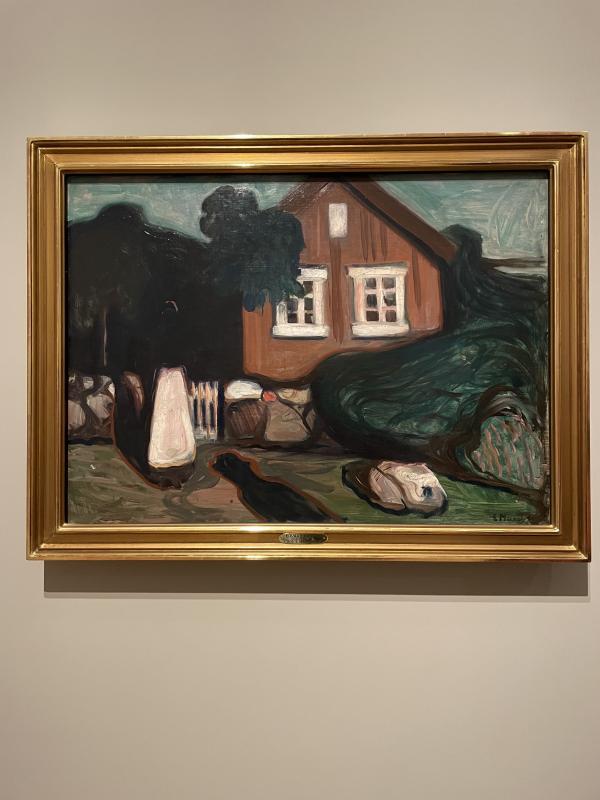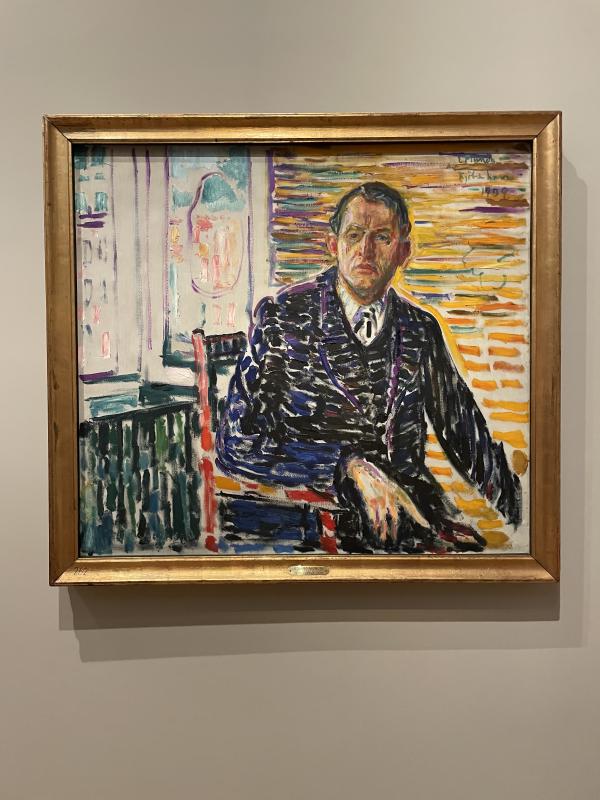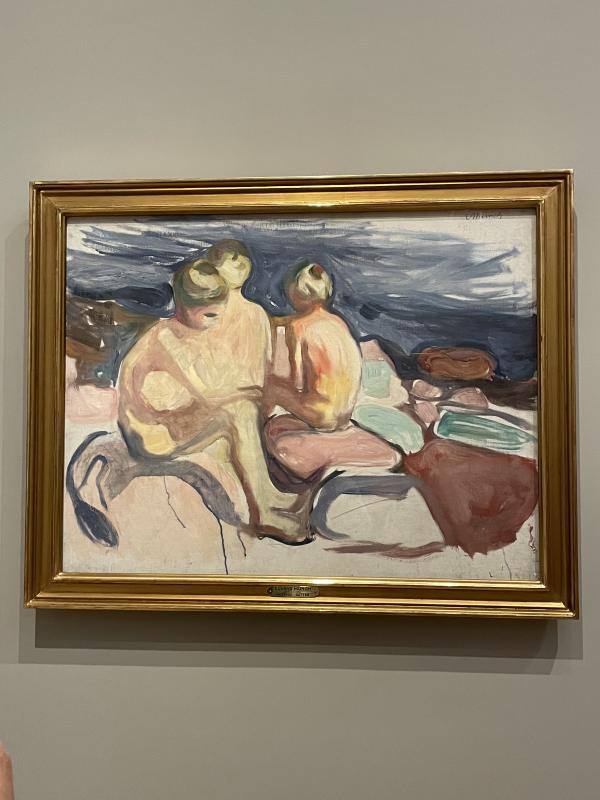Munch @ the Courtauld
ZM
Emoji summary: 🌫 🕰 🗜
It is warm but a breeze cuts through as I walk down the Strand. I’m on the sunny side of the road, leafy shadows pass overhead, my sunglasses slip down my nose. The wind still whips my ponytail, blows wispy baby hairs back and forth so they get caught in my lip balm. I feel like a morning person. I am happy to be out and alive in The City. I smell like orange blossom and bergamot and I am stomping down the Strand, moving faster than the buses and the black cabs.
Do you ever have those kinds of mornings? You’re just in a good mood for no reason. The world is the world all the same, but it feels vivid and clear and you are glad for the ways in which you are alive. I hope you do. I take photos of the clouds when I run through the park because I don’t want to forget the way it feels, to sweat under a wide rippling sky. I take photos when I see small dogs, faces in pavement chewing gum, happy swirls of colour and sun beams. I saw someone blowing bubbles for a cheering toddler in the Tesco car park. Life is a collection of images on our phones and in our minds and we give those images meaning with our lives. The life is the container for the images - or maybe the image is the container for the crumb of life it is paired with? I can’t tell. My phone is pressed to my hip and warm from my body, always ready to go. Meaning doesn’t have to be articulated clearly, often it is just a feeling that blooms in the swell of your stomach. It is just something that catches your throat when you swallow.
When I look back at my life, I don’t want to remember myself. I want to remember the feeling and mood that I was swimming about in while my life took place. Like maybe a direct image of my heartbreak or happiness will be too sharp. I want to look back at it through a screen, see pollen floating through the air and purple Tottenham skies and the neighbourhood cats gathering by the bins at dusk.
When I get to Somerset House, the sun is pouring itself wide across the courtyard. I am wearing white Nikes that sigh softly against the cobblestones. I finally break a sweat once I have climbed the stairs to the top floor of the Courtauld. I am here to see the paintings by Edvard Munch.
Spring Day on Karl Johan (1890). The street stretches out as far as the middle distance. It disappears into a pinched hazy grey block. Crowds move away, but two long shadows are being cast from the left. They are bodiless. The road in front is glimmering in the sun and heat. The light is white and peach and minty green in dappled strokes, like scales or grit. The shadows are dirty navy blue. Photos are not true or faithful. The camera is a lazy viewer so I try to take photos that feel honest - I know that honest is a yardstick that only makes sense to me, but I’m ok with that. The photos are just for me so I have space to create meaning and honesty anew each time I hit the shutter. I try to make something that is closer to the mood than to what the camera is actually seeing. A pond slicked in green algae, grass twitching in the wind, shimmering skin at my temples crinkling as I squint at the sun.
Summer Night. Inger on the Beach (1889). The rocks are round and veiny, like meat or little lumpy bodies. Blue and pink and peach and red brown or green in parts. The sea is soft. The light hits it in subtle purple, like a lilac shift that I only notice when I come back to look the second, third time. There’s a pinky red washed over the blue. It’s the kind of thing I feel satisfied for noticing and that I also admire artists for noticing. The way a painter must look at the world is deeply romantic to me because it is so intimate, so knowing. To get that close and observe with such intensity? Ah isn’t that a kind of love! There is romance in seeing something, regardless of whether it’s sincere or accepting or even true. Inger sits on these large, present rocks and looks off to the left. Her white skirt is rounded, her knee a soft curve and hip dipping. She looks like a kind of rock too, silken across the landscape and perched on the backdrop of the sea and herself.
Moonlight on the Beach (1892). A dark shoreline with the sea on one side and the forest on the other. We look through the middle at a rocky path, the moon copies itself down the canvas overhead. The paint is thin and scratchy on the edges: the deep green of the trees and the dark purple grey of the shore. You can see the scrape marks of a dry brush shifting the paint over. The rocks on the path are painted like they are pasted on. The sea is flat and blue grey, luminous in the half-dark, milky cloudy like bathwater, a thick and solid jelly. The moon gets milkier too as it doubles and triples down in a line, picking itself over and over with blood red and ochre. This landscape is hazy and smoked flat - but parts of it pull together and the contrast makes a sharp relief. But when I look at each part, I feel like I am peering through the soft filter of a window blurred by fingerprint kisses.
I want to mark my life with images that hold meaning. Little punctures that pierce through the veil of my memory and flood me with a feeling. I am an empty vessel awaiting the arrival of something— a skin containing the rolling boil underneath. Images are perfect. They turn object and subject into shape form simmering mood. They are symbolic vehicles. Life is liquid life is open life disappears around me like it is smoke slipping out through the cracks. I want to pin a corner down so I can hold it still just long enough to wrap around me. I don’t care about the logic that drives this impulse or process. It works because I say it works. There’s no symbolic method, only feeling. The cobblestones feel like shimmering scales. The moon feels like a milky replica. Inger’s skirt feels like a soft rock, smooth and curved against the shore.
Melancholy (1894-96). The landscape turns soupy around the figure, bending smooth shapes that open up and wallow in awe of themselves. The rocks are lozenges, soft and hollow. They melt into the shape of the lilac sea. Everything peels away, even the sky ripples away from the horizon, wave cresting. But the figure is outlined in black. He is flat and sallow, stark against the soft landscape behind him. He is thrust out towards us, a kind of alienation where he is clear and close. Suffering is universally lonely, isn’t it? We all experience it but it is an individual tight grip. Maybe that’s the melancholy? I don’t know. I think if I had to be in this landscape, I’d want to be part of the bending tideline as it bursts. I’d want to be the shimmering purple waves, flat metal warping where I met the land.
House in Moonlight (1893-95). Imagine it is twilight. The sun has dipped below the horizon but light is still scattering shadows past the clouds. A house with two heavy windows and a stone wall, dark trees balloon out like storm fronts. A woman stands to the left. All I can see is the white apron over her skirt and the solid black of her shadow draping over the wall behind her. Maybe the peak of her hairline, barely barely. Another shadow, bodiless, teeters up to meet her. The painting is all cartoon packet colours. The green of the trees is dark but vivid, like it’s straight from the tube. There are streaks of veridian trapped in the translucent wash where the paint thins out. The brown of the house is pasty, cut with white so it glows against the thin green. The ground is a mossier pea green, lines twist imperfect around the shadows. They are all dancing. It feels vivid in the same way dreams and memories do. The way we conjure an image of things in our minds, but they are more aggressive or forcefully rendered. The black is black, everything is hard and absolute. The wall text talks about how this painting is charged with clandestine possibility, but I don’t see it. House in Moonlight feels so solid and stuck, like when you have reached an impasse or a threshold you cannot cross. The past, punching in a dream, this painting - all fixed down and they won’t budge.
Bathing Boys (1904-05). All I see are bodies merging in sunlight. Skin on skin fading under the glowing heat, yellow and pink. Bodies stretch out into a field of colour and the only outline is a very slight browned shoulder, the colour shifting only a little. Three boys perched on the minty green rocks by an impatient sea. The rocks droop over each other like chewing gum. The sea is a suggestion of blue lines hurrying past, dry brush striking the canvas around the figures like an afterthought. As they pass behind me, a young couple talk to each other about this painting. They’re holding hands. One says, ‘bit weird painting naked kids, isn’t it?’ and I blink, listening. I hadn’t even thought about this painting as an image with subjects. I was sucked into it as colour and form, surface and space. I forgot for a moment that this wasn’t just about skin and bodies as image, image untethered from real life, feeling and feeling. It has dissolved in front of me and all I can see is red brown and blue.
Self Portrait in the Clinic (1909). I think this painting is taking place on very very pale lilac grounds. The pink and purple and blues all glow out. Strokes that are isolated and distant feel cute, sweet. Whimsical? That feels like a silly word, but maybe I mean it. I can see the force behind them, where the brush has been pushed into canvas and made the marks into clipped edges. Baby pink dashes and pasty blue gradients that cloud over into white. Munch’s face is rigid thick, but he is glowing. There’s a golden halo that runs down from the top of his head and all the way down his right side like an egg yolk outline, buttery and beautiful. Piecing an image of yourself together, surrounded by jagged colour and lines that carry rhythm. There is dark red in the shadows of his face and dark green under his eyes.
I leave through the public galleries. Down the steps and back out into the bright courtyard. That’s what they say about Munch, isn’t it? That his paintings are heavy, images conjured as symbols of the stages of life and the way we mark them and remember them. I want to feel that, I want to understand the way my relationship to images feels in comparison to that. Maybe it’s about stillness? Or the way images can appear banal at first, but then twist away into something else as you look back. Maybe it’s about the beauty of rolling hills, casual brush marks that are thrown on in the perfect place. Energy energy, I think Munch’s paintings have got energy and it fills the tense space between the painted surface and me. Because life tumbles away from us (from me). In the blink of an eye all of a sudden I have no idea how it happened, but I am here and I am happy. Maybe it is because I have been asleep all this time, lost in a haze of other things that I can’t or won’t remember. But now I want to be painfully awake for it all. I want to experience everything vividly. I want to remember!!! Even when I am heartbroken or furious, I want to remember that I am alive and I am human and I am living in a dream I have built for myself. I hold my phone tight against my hip, feel that it is warm from exertion and my body. I can just create honesty anew each time I hit the shutter. It’s fine, because it’s for me only.
Edvard Munch: Masterpieces from Bergen is on at the Courtauld until 4th September.
